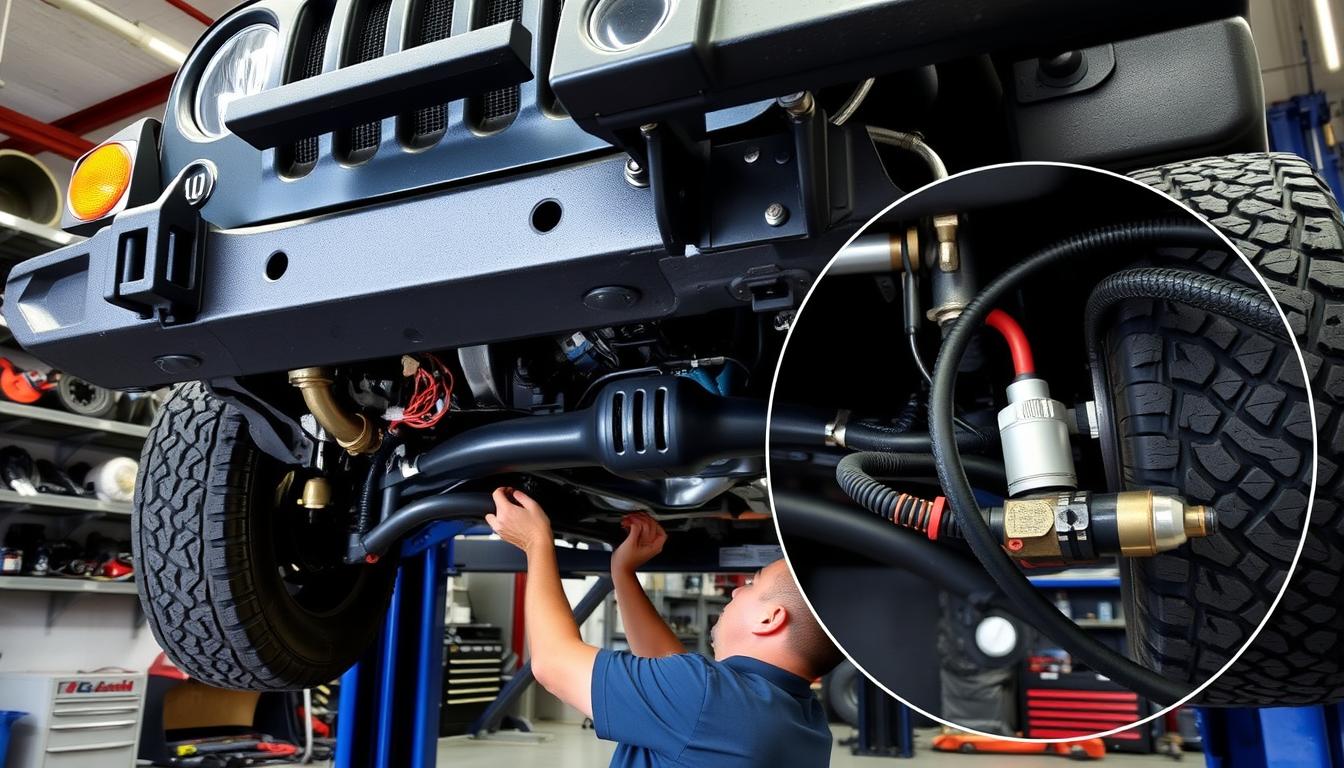Replacing an O2 sensor is a simple task if you know what to do. If you’re looking to replace your Jeep Wrangler’s O2 sensor, you’re in the right place. We’ll show you how to do it in 5 easy steps.
This guide is for both seasoned mechanics and DIY enthusiasts. We’ll cover why O2 sensors are important and how they work. Then, we’ll talk about the tools and materials you’ll need for the job.
Key Takeaways
- Jeep Wrangler JK is sensitive to oxygen sensors other than NGK / NTK
- NTK O2 sensors are consistently required for proper functioning of the Jeep Wrangler JK
- Using anti-seize on new O2 sensors is highly recommended
- NTK O2 sensors have a shared numbering system with NGK
- Using non-recommended O2 sensors can lead to diagnostic issues
- A proper jeep wrangler o2 sensor replacement can be done with the right guidance
Understanding O2 Sensors in Your Jeep Wrangler
The oxygen sensor is key to your Jeep Wrangler’s performance and fuel efficiency. It’s a vital part of the emissions system. If your Jeep Wrangler has poor gas mileage or a check engine light, a bad O2 sensor might be the cause. Replacing it can fix these problems.
A bad O2 sensor can lead to lower engine performance and more emissions. To replace it, you need to find the sensor, disconnect the battery, and take out the old one. Knowing how to do this is important. You also need to understand the different O2 sensors and how to spot a failing one.
What Does an O2 Sensor Do?
An O2 sensor checks the oxygen levels in your exhaust system. It sends this info to the engine control unit (ECU). The ECU then adjusts the air-fuel mix for better engine performance and less emissions. A bad O2 sensor can mess with this, causing problems.
Signs of a Failing O2 Sensor
Common signs of a failing O2 sensor include a check engine light, poor gas mileage, and failing emissions tests. If you see these signs, it’s time to check and replace your O2 sensor. Regular maintenance, like O2 sensor replacement, keeps your Jeep Wrangler running well.
Types of O2 Sensors in Jeep Wranglers
Jeep Wranglers use different O2 sensors, like upstream and downstream ones. Upstream sensors are before the catalytic converter, and downstream sensors are after. Knowing which one your Jeep has is key for proper replacement and care.
Required Tools and Materials for O2 Sensor Replacement
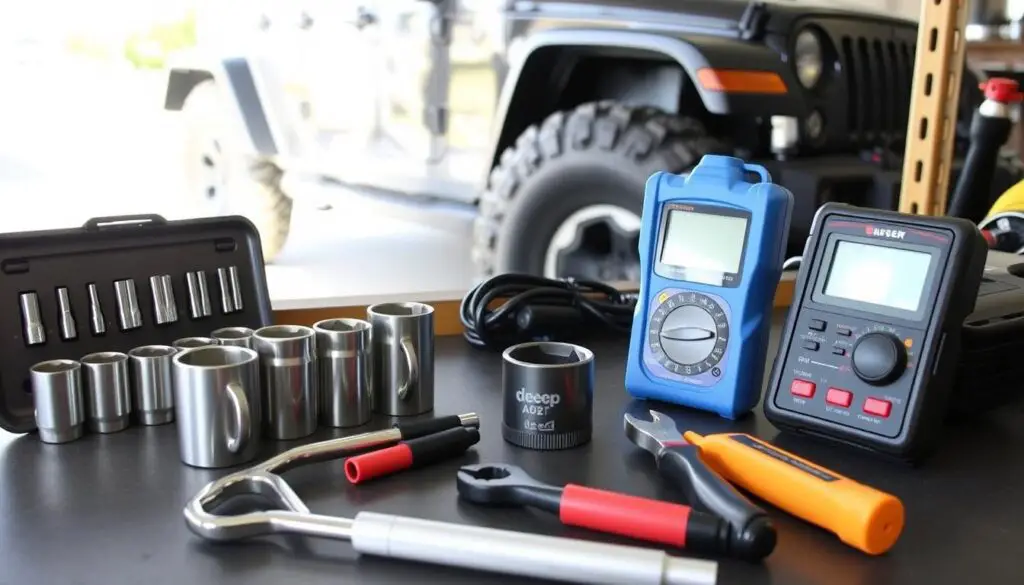
To replace the jeep wrangler o2 sensor successfully, you need the right tools and materials. You’ll need an O2 sensor socket and a ratchet wrench. Also, get a new O2 sensor, the best o2 sensor for jeep wrangler, for top performance.
Here’s a list of what you’ll need:
- O2 sensor socket
- Ratchet wrench
- New O2 sensor (best o2 sensor for jeep wrangler)
Choosing the right O2 sensor is key for a smooth replacement. Look for one that fits your Jeep Wrangler well, is durable, and affordable.
With the right tools and materials, you’re set for the jeep wrangler o2 sensor replacement. Always wear safety gear and check your car’s manual if you’re unsure about anything.
| Tool/Material | Description |
|---|---|
| O2 sensor socket | Used to remove and install the O2 sensor |
| Ratchet wrench | Used to tighten and loosen bolts and nuts |
| New O2 sensor | Replaces the old O2 sensor to ensure optimal engine performance |
Locating Your Jeep Wrangler O2 Sensor
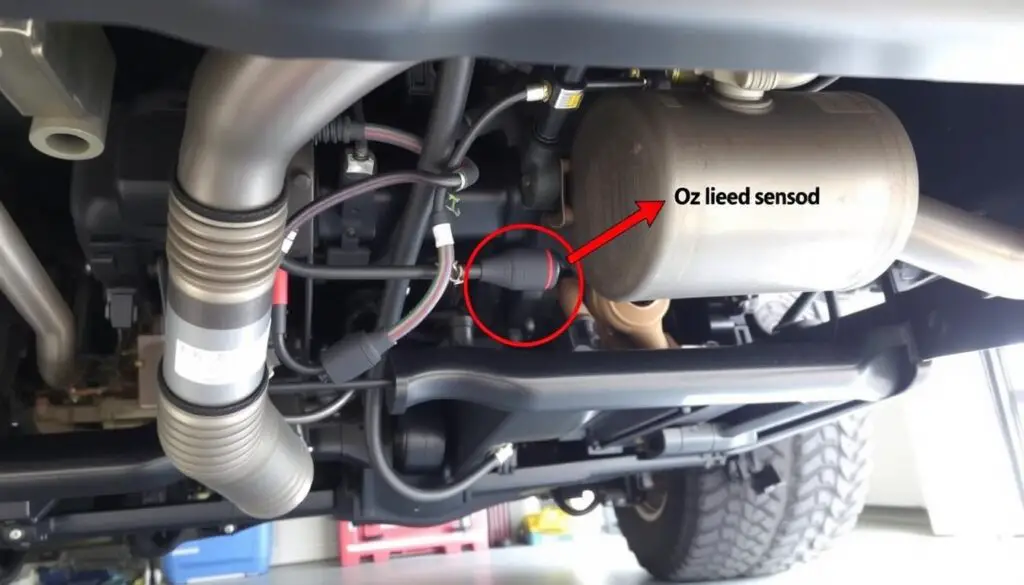
To replace your Jeep Wrangler’s O2 sensor, you first need to find it. The O2 sensor’s spot can change based on your vehicle’s model year and type. For a jeep wrangler upstream o2 sensor, it’s usually near the exhaust manifold. Knowing where the jeep wrangler o2 sensor is is key for the replacement.
The jeep wrangler o2 sensor’s spot can differ by model year. Here are some general tips for different model years:
- 2001-2003 (First Generation): The upstream O2 sensor is near the exhaust manifold. The downstream sensor is near the catalytic converter.
- 2004-2006 (Second Generation): The O2 sensor’s spot is similar to the first generation, but with some small changes.
- 2007-2018 (Third Generation): The jeep wrangler upstream o2 sensor is near the exhaust manifold. The downstream sensor is near the catalytic converter.
- 2018-2021 (Fourth Generation – Wrangler JK) and 2021-2023 (Fifth Generation – Wrangler JL): The O2 sensor’s spot is similar to the third generation, but with some small changes.
It’s crucial to check your vehicle’s repair manual or talk to a trusted mechanic if you’re not sure about the O2 sensor’s location. Always follow proper safety steps when working with your vehicle’s exhaust system.
Safety Precautions Before Starting

When you’re replacing the o2 sensor in your jeep wrangler, safety is key. Safety precautions are vital for avoiding injuries and ensuring a smooth process. Electrical and fuel systems can be dangerous if not handled correctly.
To stay safe, follow these steps:
- Wear protective gear, including gloves and safety glasses
- Ensure proper ventilation in your workspace
- Avoid electrical shocks by disconnecting the battery before starting work
A good work light is also essential. It helps you see clearly, preventing accidents. Using a flexible locking head wrench and a 10mm socket can also help. They prevent bolts from getting damaged and make the replacement easier.
By taking these precautions, you can replace your jeep wrangler o2 sensor safely. Always check your vehicle’s manual for specific instructions and guidelines.
| Safety Precaution | Importance |
|---|---|
| Wearing protective gear | High |
| Ensuring proper ventilation | High |
| Avoiding electrical shocks | Critical |
Complete Jeep Wrangler O2 Sensor Replacement Guide
Replacing the O2 sensor on your Jeep Wrangler is easy. You just need a few tools and some basic knowledge. To replace the O2 sensor, start by disconnecting the battery. Then, remove the old sensor, install the new one, and reconnect everything. The jeep wrangler o2 sensor cost varies, but it’s usually between $150 and $400.
Here’s how to do it:
- First, disconnect the battery to avoid any accidents or shocks.
- Next, take out the old O2 sensor by loosening the bolt and pulling it out.
- Put in the new sensor, making sure it’s tight and secure.
- Lastly, reconnect all the electronic parts, like the wiring harness.
Always follow safety rules and consider getting help from a pro if you’re unsure. Learning how to replace o2 sensor on jeep wrangler can save you money and make you feel proud.
Before buying, check the jeep wrangler o2 sensor cost and compare prices. With the right tools and knowledge, you can replace your Jeep Wrangler’s O2 sensor quickly.
| Model Year | O2 Sensor Replacement Cost |
|---|---|
| 2011-2017 | $150-$300 |
| 2018-2023 | $200-$400 |
Common Challenges During Replacement
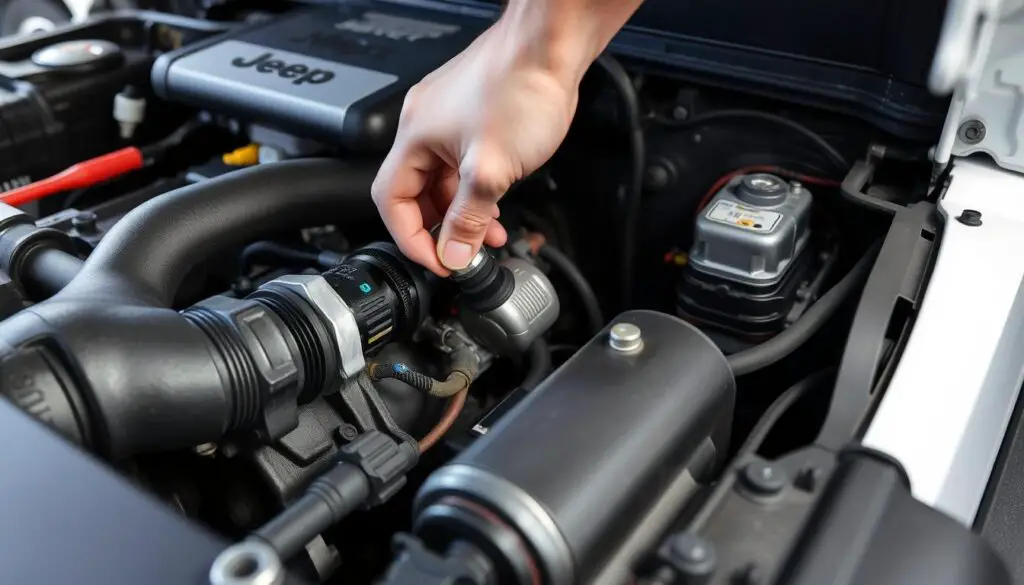
When you replace an jeep wrangler o2 sensor, you might run into some common challenges. These can include corroded sensors or faulty electrical connections. Many people face issues like these.
Corroded sensors, stuck threads, and bad electrical connections are common problems. To solve these, you need the right tools and to know what you’re doing.
Here are some tips to help you:
- Use a special O2 sensor socket for easier installation and removal.
- Apply anti-seize to the threads to make future removals easier.
- Choose the right replacement sensor, like an NTK sensor, for your Jeep Wrangler.
Knowing these common challenges and how to solve them can make your jeep wrangler o2 sensor replacement go smoothly.
Always wear safety gear and check your owner’s manual or talk to a mechanic if you’re not sure about anything.
| Challenge | Solution |
|---|---|
| Corroded sensors | Use a wire brush to clean the sensor and apply anti-seize to the threads |
| Stuck threads | Apply penetrating oil to the threads and let it sit before attempting to remove the sensor |
| Faulty electrical connections | Check the wiring and connections for any damage or corrosion, and replace as needed |
Testing Your New O2 Sensor Installation
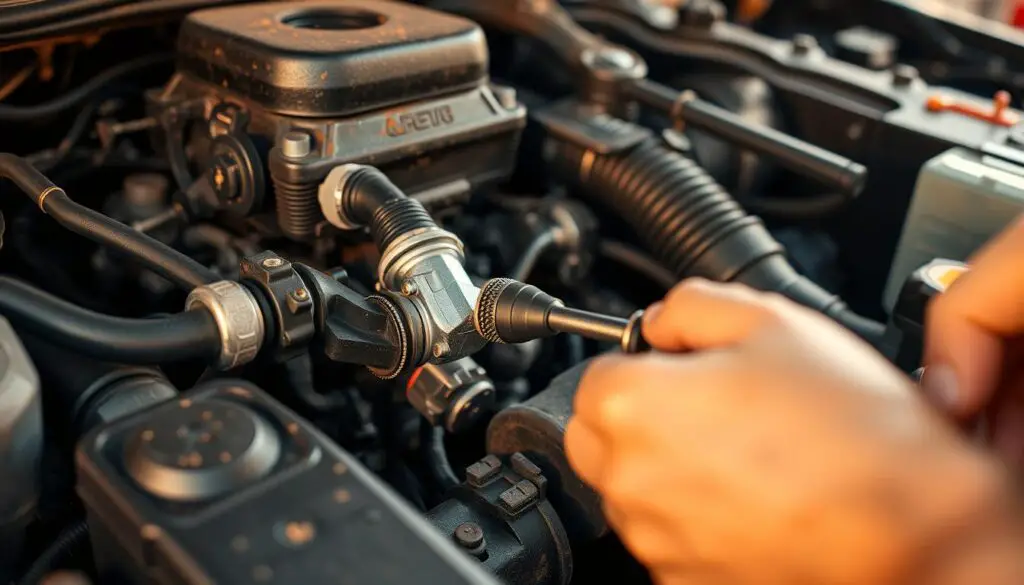
After you’ve replaced the O2 sensor in your Jeep Wrangler, it’s crucial to test it. This ensures it’s working right. You should see the O2 sensor voltage swing between 0.1 and 0.9 volts when the engine is idle. At 2000 RPM, it should be between 0.4 and 0.5 volts.
To check if your vehicle is running well, use a digital meter for the grounds and voltage to the heater. But, you need an analog meter to see the O2 sensor voltage. A bad ground connection can mess up the ECU’s signal. This might lead to poor fuel efficiency, even with a good O2 sensor.
Here are some important things to check during the test:
- O2 sensor voltage at idle: 0.1-0.9 volts
- O2 sensor voltage at 2000 RPM: 0.4-0.5 volts
- Ground connection resistance: less than 1 ohm
By following these steps, you can make sure your new O2 sensor is working right. This will help your vehicle run smoothly. Always check your vehicle’s repair manual for the best way to test the new installation.
| O2 Sensor Voltage | Idle | 2000 RPM |
|---|---|---|
| Optimal Range | 0.1-0.9 volts | 0.4-0.5 volts |
Cost Considerations for O2 Sensor Replacement
Replacing the O2 sensor in your Jeep Wrangler involves cost considerations. The price can change based on the sensor type, labor, and other costs. Recent data shows oxygen sensor replacement costs range from $200 to $600, including parts and labor.
Upstream O2 sensors are pricier than downstream ones. For example, an aftermarket NTK Oxygen Sensor costs $66.99, while a 2015 Toyota RAV4 Oxygen Sensor is $153.99. Labor costs in the U.S. are between $110 and $175 per hour, affecting the total cost.
The time needed to replace oxygen sensors varies from 45 minutes to three hours. Labor costs can be $82.50 to $525, based on the hourly rate and job time. Here are some estimated prices for oxygen sensors:
- NTK Oxygen Sensor 27018: $66.99
- Denso Exact Fit Oxygen Sensor 234-5176: $96.99
- Ford Motorcraft Oxygen sensor HEGO DY1299: $93.92
Choosing the right brand for your Jeep Wrangler’s O2 sensor is key. NGK/NTK are recommended for Jeep Wrangler JK. Other brands like Bosch and Chinese generics might not work well, causing check engine lights.
Preventive Maintenance Tips
Regular maintenance is key to avoid O2 sensor failure and keep your vehicle running well. By following these tips, you can make your O2 sensor last longer and dodge expensive fixes. For a jeep wrangler o2 sensor replacement, remember to check and swap out the air filter, spark plugs, and other parts often.
Some important preventive maintenance steps include:
- Checking the air filter every 15,000 to 30,000 miles
- Replacing the spark plugs every 30,000 to 100,000 miles
- Inspecting the O2 sensor wires and connections for damage or corrosion
By keeping up with these tasks, you can prevent O2 sensor failure and keep your vehicle in top shape. Always stick to your vehicle’s maintenance schedule to keep it running great and lasting longer.
Also, using top-notch parts and following the right installation steps can help avoid O2 sensor problems. Taking a proactive maintenance approach can save you time and money down the line.
| Maintenance Task | Recommended Interval |
|---|---|
| Air filter check | 15,000 to 30,000 miles |
| Spark plug replacement | 30,000 to 100,000 miles |
| O2 sensor wire inspection | Every 30,000 miles |
Troubleshooting Post-Installation Issues
After replacing the jeep wrangler o2 sensor, you might face some issues. These can include a check engine light, performance problems, or sensor errors. To solve these, you need a step-by-step plan.
Poor gas mileage is a common problem. It shows the sensor’s effect on fuel use. Always replace O2 sensors in pairs, even if just one is bad.
Check Engine Light Problems
A bad oxygen sensor can cause the check engine light to come on. The sensor’s readings should be between 200 and 800 millivolts. If it’s not, it’s likely failed.
Performance Issues
Performance problems can happen if the sensor is installed wrong or is faulty. Heated sensors last about 60,000 miles, and unheated ones last about 30,000 miles. Regular checks and replacements can prevent these issues.
Sensor Communication Errors
Communication errors can happen if the new sensor doesn’t work with your car’s system. NGK checks part numbers twice to ensure they’re correct for every model year.
Fixing post-installation issues takes patience and careful attention. By following a detailed plan and knowing common problems, you can solve issues with your jeep wrangler o2 sensor. This ensures your car runs well and uses fuel efficiently.
Conclusion
Replacing the O2 sensor in your Jeep Wrangler is easy with the right tools and knowledge. Understanding the O2 sensor’s role in your vehicle’s performance is key. By following this guide, you can replace your Jeep’s O2 sensor confidently. This ensures your engine runs well and uses fuel efficiently.
The jeep wrangler o2 sensor replacement process needs careful attention and safety. With the right steps, you can avoid common issues and replace it successfully. Always test your new O2 sensor to make sure it works right and doesn’t show any error codes. This way, you’ll get better engine performance, fuel efficiency, and a smoother ride.
In conclusion, replacing your Jeep Wrangler’s O2 sensor is simple with the right help. This article has given you the tips and confidence to do it yourself. Whether you’re a pro mechanic or a DIY fan, this guide has helped you. You’re now ready to do this important maintenance task.
FAQ
What is the purpose of an O2 sensor in my Jeep Wrangler?
What are the signs of a failing O2 sensor in my Jeep Wrangler?
How do I locate the O2 sensor in my Jeep Wrangler?
What tools and materials do I need to replace the O2 sensor in my Jeep Wrangler?
How much does it cost to replace the O2 sensor in my Jeep Wrangler?
Can I replace the O2 sensor in my Jeep Wrangler myself?
What are the common challenges during O2 sensor replacement in my Jeep Wrangler?
How do I test the new O2 sensor installation in my Jeep Wrangler?
What are the preventive maintenance tips to avoid O2 sensor failure in my Jeep Wrangler?
What are the troubleshooting steps for post-installation issues with my Jeep Wrangler’s O2 sensor?

Hello there, this is Thomas Byrd. I am a professional car mechanic who leads a team of junior mechanics in a repair and restoration shop. In the beginning, I used to work for a jeep service center as a basic worker. From there I keep learning, changed my job 2 times and now I am a professional who leads a group of mechanics. Though a have expertise in the jeep, I know very well about all types of cars. To share my knowledge and skills with others I have created this blog website. Whenever I get free time from work I give my time to my blog.

